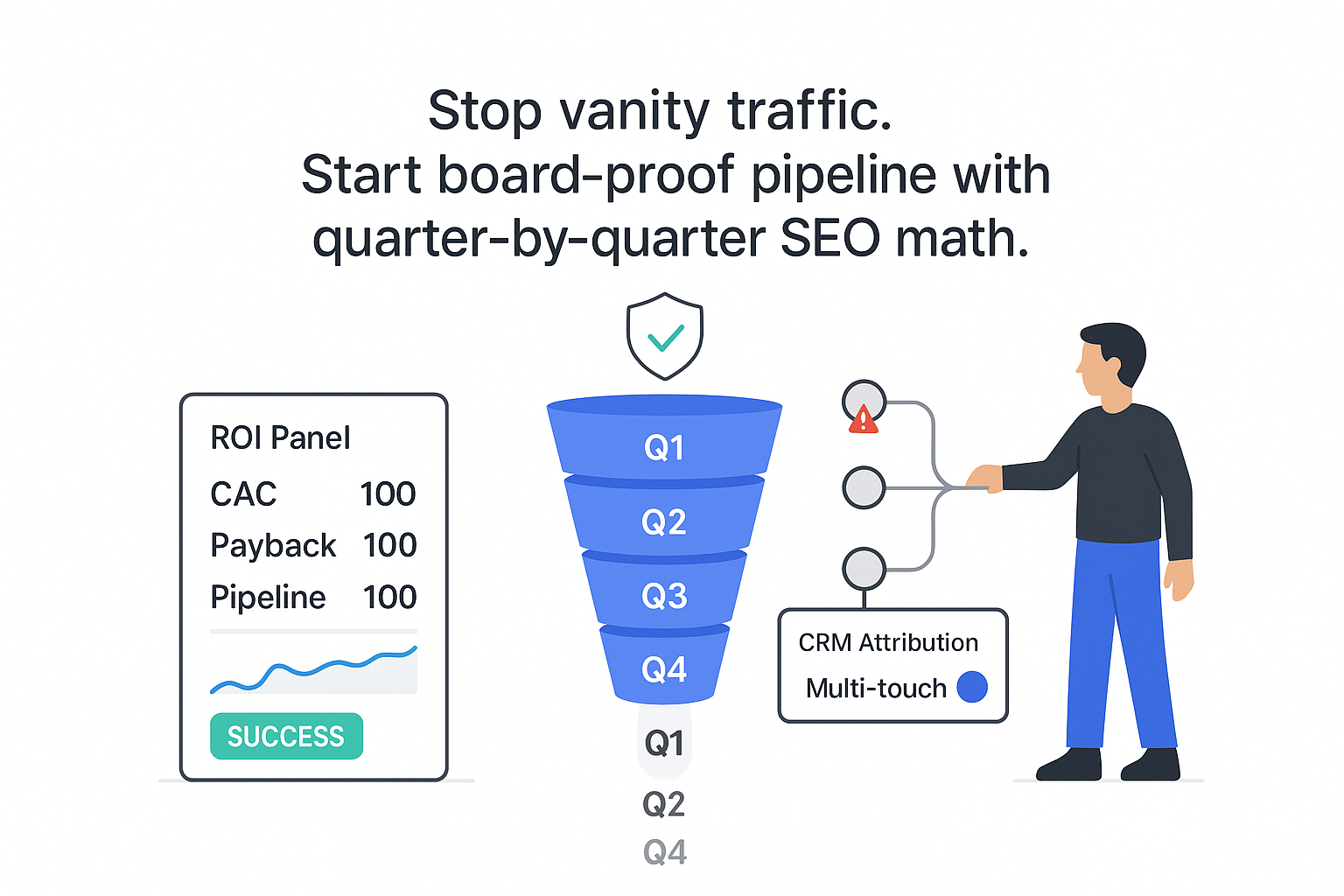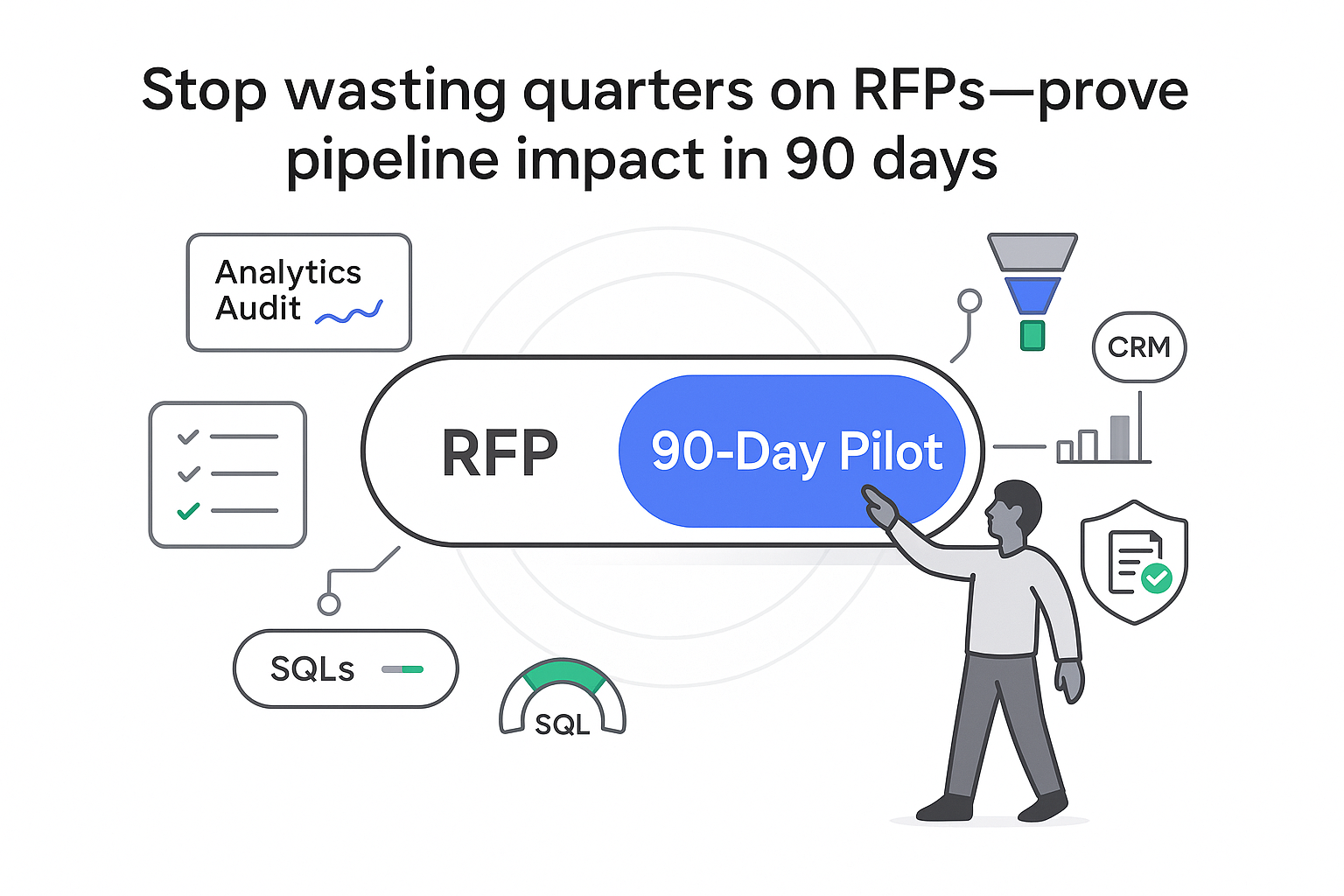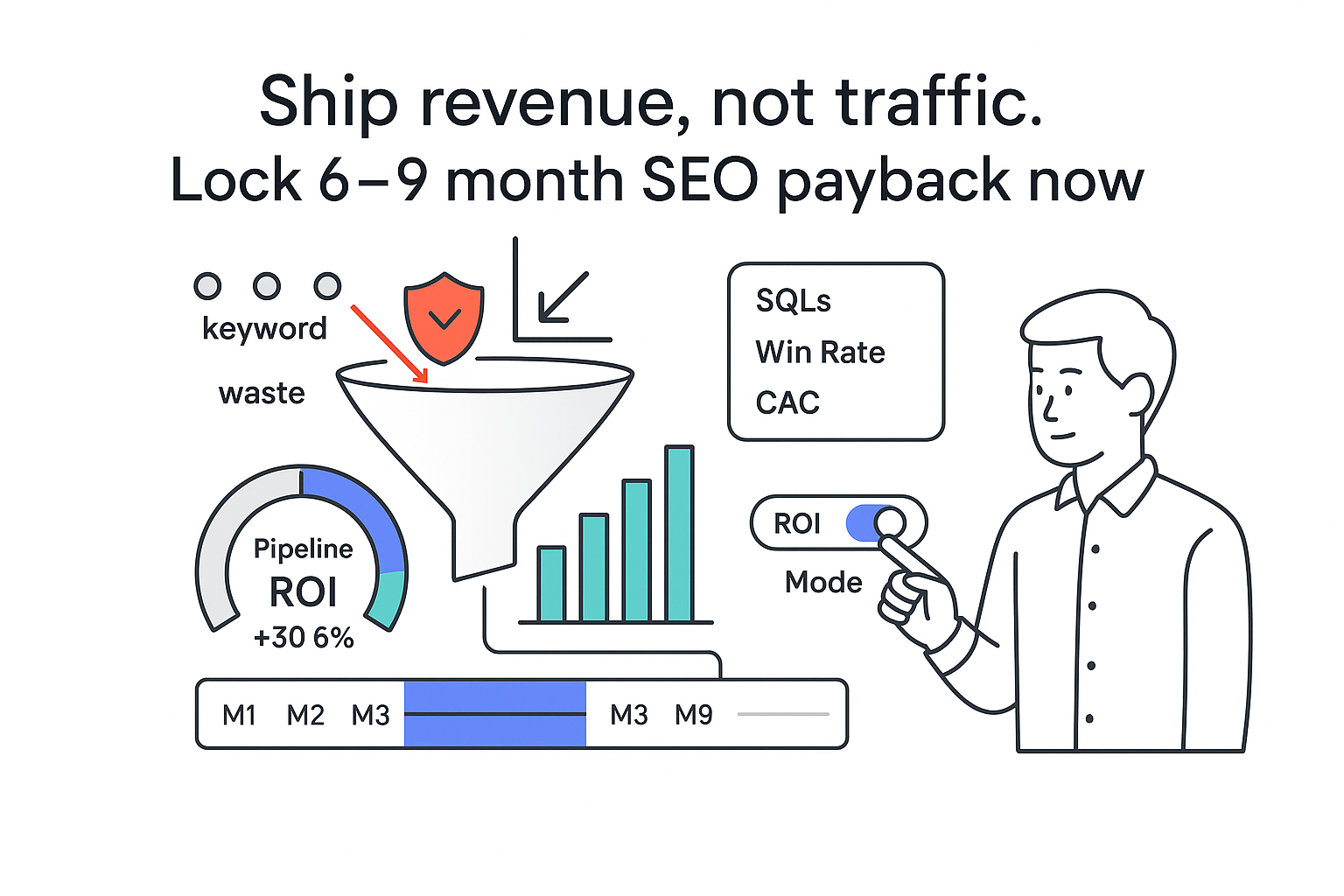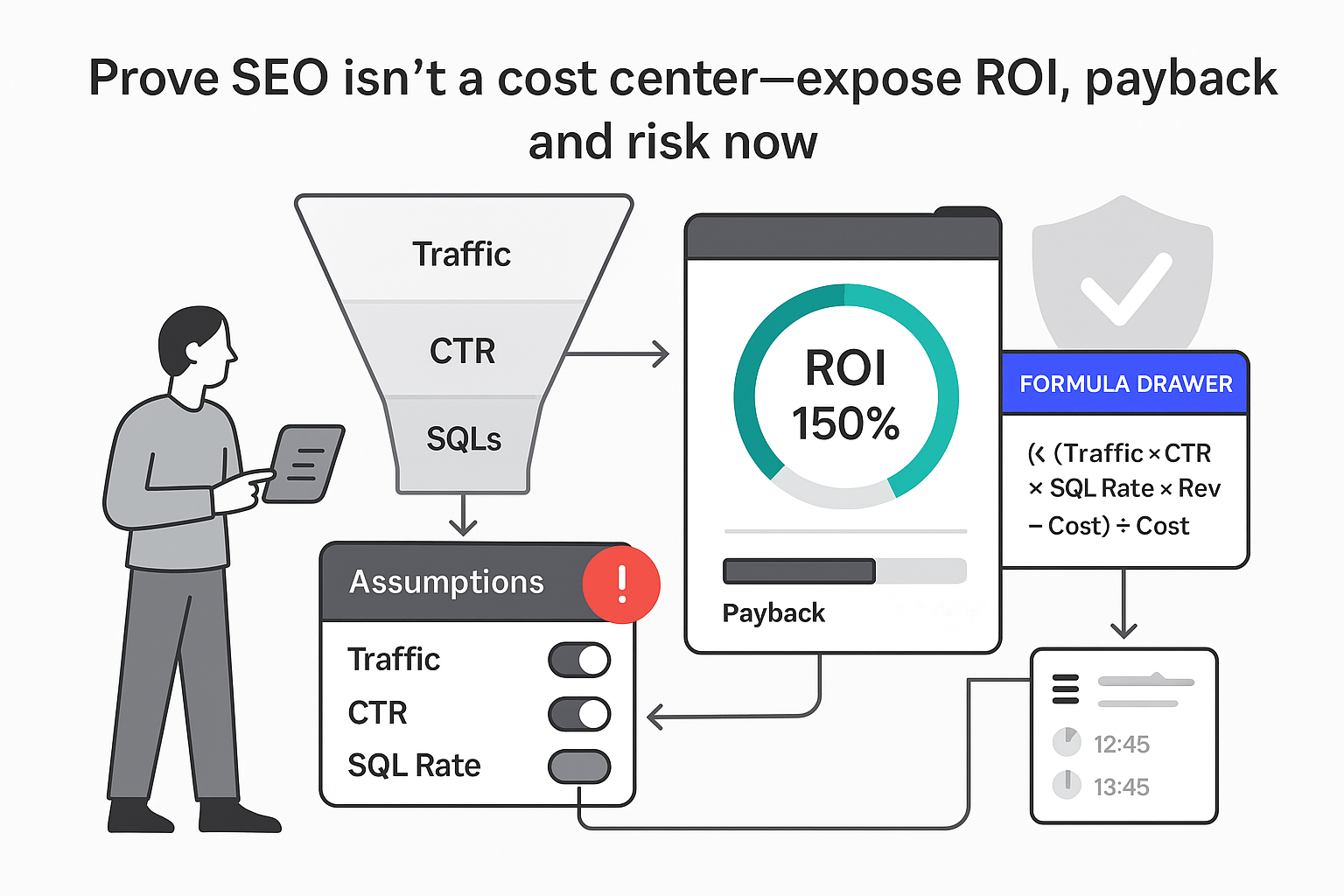If I run a B2B service company, I want SEO that pulls its weight without hijacking my calendar. I want math, not magic - a plan that fits my sales cycle, ties to pipeline, and does not require babysitting a dozen moving parts. That is what a good B2B SEO program should feel like: clear targets, crisp execution, steady compounding. Here is the plain-English map and where the ROI shows up, quarter by quarter.
B2B SEO ROI: a simple model
I start with a lightweight model for a board deck - traffic to lead to revenue math that anyone can audit.
-
Define targets (example)
- MRR goal: 100,000 dollars
- Average deal size: 50,000 dollars ARR
- Sales cycle: 60 to 120 days
- Close rate from SQL: 20 percent
- Lead to SQL rate from MQL: 40 percent
- Visit to MQL rate for bottom and mid-funnel pages: 1.5 to 3 percent
-
Work backward from revenue
- 100,000 dollars MRR equals 1.2 million dollars ARR
- New ARR needed per quarter to be at run rate by Q4: roughly 300,000 dollars
- Deals per quarter at 50,000 dollars ARR: 6
- SQLs required at a 20 percent win rate: 30
- MQLs required at 40 percent to SQL: 75
- Visits required at 2 percent visit-to-MQL: 3,750 qualified visits to bottom and mid-funnel pages
-
Traffic quality matters more than volume
- If about half of visits land on service, pricing, comparison, and case study pages, the model holds
- If most visits land on fluffy, non-commercial posts, the model breaks
Worked example to sanity-check CAC and payback
- Quarterly SEO investment: 18,000 to 30,000 dollars
- Pipeline added in Q2 from SEO-influenced leads: 400,000 dollars
- Closed ARR in Q3 from that cohort: 100,000 to 150,000 dollars
- CAC that quarter: 18k to 30k divided by 100k to 150k ARR equals 12 to 30 percent CAC to ARR
- With a 3-year LTV of 120,000 dollars per client, LTV to CAC sits well above 3. That is healthy for most B2B service models
I always calibrate these inputs with real baselines from analytics and CRM. If conversion rates are unknown, I bracket them with conservative and aggressive scenarios and show a range so the board sees both confidence and variance.
Quarterly milestones and payback
SEO compounds, but it does so in a pattern that matches B2B cycles.
-
Q1: foundations and quick wins
- Fix indexation and speed issues, ship or improve core service pages, refresh intent on priority URLs, and strengthen internal linking
- Expect leading indicators: crawl coverage gains, better Core Web Vitals, and early ranking lifts for long-tail terms
-
Q2: pipeline velocity
- Launch case studies and comparison content, publish transparent pricing content, and begin earning authoritative mentions
- Expect MQLs and demo requests to climb; first SEO-influenced opportunities enter the pipeline
-
Q3: compounding growth
- Topical depth improves authority, partner placements stack, and more commercial intents start to rank
- Expect new logos closed from SEO, rising assisted revenue in CRM, and better close rates due to better-qualified inbound
Simple payback view
- Payback in months equals SEO program cost divided by initial gross margin from closed SEO deals
- With typical B2B sales cycles, expect six to nine months to full payback; it can be faster if brand demand and warm traffic already exist
Reporting and attribution that tie to revenue
I want reporting that focuses on revenue mechanics, not vanity.
- Channel mix with organic’s share of pipeline and revenue by stage
- SEO-influenced pipeline by cohort (first-touch organic plus multi-touch models such as position-based or time-decay)
- MQL-to-SQL conversion by page type (service, pricing, comparison, case study, educational)
- Assisted revenue tied to the specific URLs that contributed to stage movement
- Clear snapshots or exports from analytics and CRM so finance can trace each claim to source
Strategy that protects pipeline quality
I keep the strategy simple and mapped directly to sales-qualified pipeline.
-
ICP and problem-to-solution mapping
- Who buys, what hurts, how they search when the pain spikes, and what proof they require before they sign
-
Funnel balance that protects lead quality
- Bottom of funnel first: services, pricing, use cases, integrations, comparisons
- Mid funnel for validation: case studies, ROI explainers, industry frameworks
- Top funnel for attention with intent discipline: guides and trends that tie back to real problems I solve
-
Lead quality safeguards
- Negative keyword and topic themes to avoid student or DIY intent
- Form routing and enrichment rules to filter out poor-fit leads
- Content mapped to sales plays so reps can use assets in multithreaded deals
-
Three execution pillars tied to revenue
- Technical SEO for crawl, speed, and structured data that clarifies services
- Content strategy that targets real buying moments
- Authority building that earns mentions from sources buyers respect
Execution pillars: technical, content, authority
Technical foundations that remove friction
- Crawlability and indexation: clean directives, accurate canonicals, and removal of junk parameter pages or soft 404s
- Speed and experience: target green Core Web Vitals on mobile (for example, LCP under 2.5 seconds, CLS under 0.1, and responsive interaction)
- Asset hygiene: compress images, defer or split heavy scripts, and lazy-load where it will not harm UX
- Architecture and depth: keep money pages within three clicks; make services and industries easy to find
- Internal linking: point topical authority and high-traffic pages to bottom-funnel targets with descriptive anchors
- Structured data: use appropriate schema types for organization, services, products, FAQs, and reviews where they reflect reality
- Localization: use regional pages and hreflang if markets differ
- Governance: define done, create simple tickets, and schedule monthly technical reviews so improvements stick
Before and after I want to see
- Mobile performance and lab diagnostics move from mediocre to strong
- LCP drops meaningfully (for example, 4.2 seconds to around 2.2 seconds)
- Indexed valid pages rise while bloat in excluded reports falls
Content that maps to buying moments
-
What converts in B2B services
- Service and industry pages that share outcomes and process
- Pricing and packaging with context and guardrails
- Comparisons (you vs. category; your approach vs. risky alternatives)
- Case studies with context, metrics, and stakeholder quotes
- Top-of-funnel posts tied to pain, not traffic bait
-
A simple 90-day content map I use
- Month 1: 3 service pages, 2 industry pages, 2 case studies, 1 pricing update
- Month 2: 2 comparison pages, 2 use-case pages, 2 more case studies, 2 mid-funnel explainers
- Month 3: 6 top-funnel posts aligned to core problems, 2 ROI explainers or calculators, 2 integration pages
-
Plain-English brief example
- Page type: comparison (you vs. status quo)
- Search intent: buyers considering doing nothing
- Outline: the cost of inaction; how the service reduces risk and raises margin within 90 days; two mini case studies with numbers and a quote
- CTA: make next steps obvious - pricing, options, and how to evaluate fit
- Notes for sales: talking points, common objections, and links to proof assets
Earning authority without risk
-
Safe, steady ways to earn mentions and links
- Original data or benchmark insights that others want to cite
- Industry associations and niche directories buyers actually consult
- Partner pages and integration hubs
- Podcasts and trade publications with practical expertise
- Thought leadership that later gets cited by industry blogs
-
How fast to go
- Under 100 referring domains: aim for 5 to 10 high-quality, relevant links per month
- At 500 plus: 15 to 25 per month is common when publishing at pace
- Quality and topical fit matter more than sheer volume
-
Outreach angles that land
- Unique, anonymized client outcomes
- Teardowns of common processes with a cleaner path
- Timely angles tied to privacy changes, search-experience shifts, or budget pressure
-
Business impact to measure
- Watch mid-difficulty bottom-funnel terms climb and assisted conversions from organic rise in CRM
Implementation and timeline
Here is the plan and ownership model that keeps things moving without micromanagement.
Phases and ownership
-
Phase 1 (weeks 1 to 4): assessment and foundation
- Deliverables: technical audit, content gap map, authority baseline, analytics and CRM wiring
- KPIs: crawl health, Core Web Vitals baselines, attribution live, target keyword map agreed
-
Phase 2 (weeks 5 to 12): pilot and first wins
- Deliverables: core service pages live, initial case studies, first PR story or placement, internal link overhaul, top-page intent refresh
- KPIs: rankings on long-tail bottom-funnel terms, first qualified demos from organic, faster indexation
-
Phase 3 (weeks 13 to 24): scale
- Deliverables: full 90-day content plan published, steady authority cadence, schema rollout, content and technical sprints
- KPIs: 30 to 60 percent growth in qualified organic sessions to bottom-funnel pages; pipeline influenced by organic visible in CRM
-
Phase 4 (ongoing): optimization
- Deliverables: topic expansion, content updates, A/B tests on page copy, fresh case studies, quarterly technical tune-ups
- KPIs: closed-won from organic-influenced opportunities; lower blended CAC as organic share rises
Roles and cadence
- Ownership model: SEO lead and content lead are responsible; a marketing owner is accountable; sales and product are consulted for quality and accuracy; executives are informed via concise reports
- Cadence: weekly sprint check-ins (what shipped, what is queued, blockers); biweekly content and PR planning; monthly executive report with attribution and a forecast to goal
Timeline by month and quarter
-
Months 1 to 2 (leading indicators)
- Indexation improves, crawl errors drop, speed scores rise
- Early ranking moves on low-difficulty phrases
- Quick wins include: rework titles and H1s on top URLs; add internal links to service pages; refresh old posts with commercial intent; add FAQ sections to win rich results; ship comparison and pricing pages
-
Months 3 to 4 (lagging indicators begin)
- Demo requests and contact forms climb
- First authority mentions and partner placements land
- CRM shows organic first-touch and assists on new opportunities
-
Months 5 to 6 (momentum builds)
- Mid-difficulty terms move to page one
- Case study traffic grows and supports late-stage conversations
- First closes from SEO-influenced pipeline
-
Months 7 to 9 (compounding effect)
- Authority gains raise entire topic clusters
- Blended CAC drops as organic share rises
- Forecastable inbound becomes real
Partner selection criteria and red flags
If I need outside help, I use a simple scorecard and watch for non-negotiables.
What I look for
- Strategy fit: content mapped to my sales process and ICP pain - not just traffic volume
- Vertical expertise: wins in B2B services with long cycles and complex deals
- Accountability: clear owners, sprint plans, and definitions of done
- Reporting: CRM-based attribution and forecast to target, not vanity charts
- Proof: case studies with metrics and named quotes
Red flags
- Vanity metrics with no link to pipeline
- Opaque deliverables or month-to-month guesswork
- No CRM attribution or pushback on wiring analytics to opportunity records
- A content factory that avoids bottom-funnel work because it is harder
Engagement models I typically see
- Monthly retainers scoped across strategy, content, technical, and authority work
- Project-based pilots to prove fit before scale
- SLAs on turnaround for tickets, drafts, and reporting
- Explicit ownership of forecasting, quality assurance, and on-time delivery
Frequently asked questions
How long does B2B SEO take to show ROI?
- Expect leading indicators in 30 to 60 days, qualified demos by months 3 to 4, and closed-won from SEO-influenced pipeline by months 5 to 9, depending on your cycle
What budget produces meaningful results?
- Many B2B service firms see traction with 12,000 to 30,000 dollars per month when scope spans strategy, content, technical, and authority
- If one pillar is already strong, reallocate spend to the constraints
How do I attribute SEO to pipeline in my CRM?
- Track first-touch organic with clean source rules
- Use position-based or time-decay models for multi-touch influence
- Connect page-level data to contact and opportunity records so you can see which URLs move deals forward
How many new pages per month are needed?
- Quality beats volume; a useful target is 6 to 10 net-new or refreshed pages per month
- Balance 3 to 4 bottom or mid-funnel assets with 3 to 6 top-funnel or integration pages
Do I need backlinks to win in B2B?
- Yes, especially for competitive commercial terms
- Steady authority growth from credible sources helps pages rank and keeps them there
How does SEO compare to paid CAC?
- Paid can move quickly but often carries higher CAC and stalls when budgets pause
- SEO usually achieves a lower steady-state CAC and builds an owned pipeline that reduces dependence on ad spend
What belongs in monthly reporting?
- An executive summary, KPI scorecard, attribution snapshots, content and authority inventory, and a forecast to goal
- A clear next-month plan so stakeholders know what ships next
Who owns content production and approvals?
- Dedicated writers draft; subject-matter experts review for accuracy; a single marketing owner approves to maintain momentum
Closing thoughts
Search is changing with AI-generated summaries and richer results, but buyers still click sources they trust. That trust is earned with fast pages, clear service stories, and real proof. When those move in sync, SEO stops feeling like a gamble and starts behaving like a reliable growth channel - and you get your time back while the numbers move.







.svg)